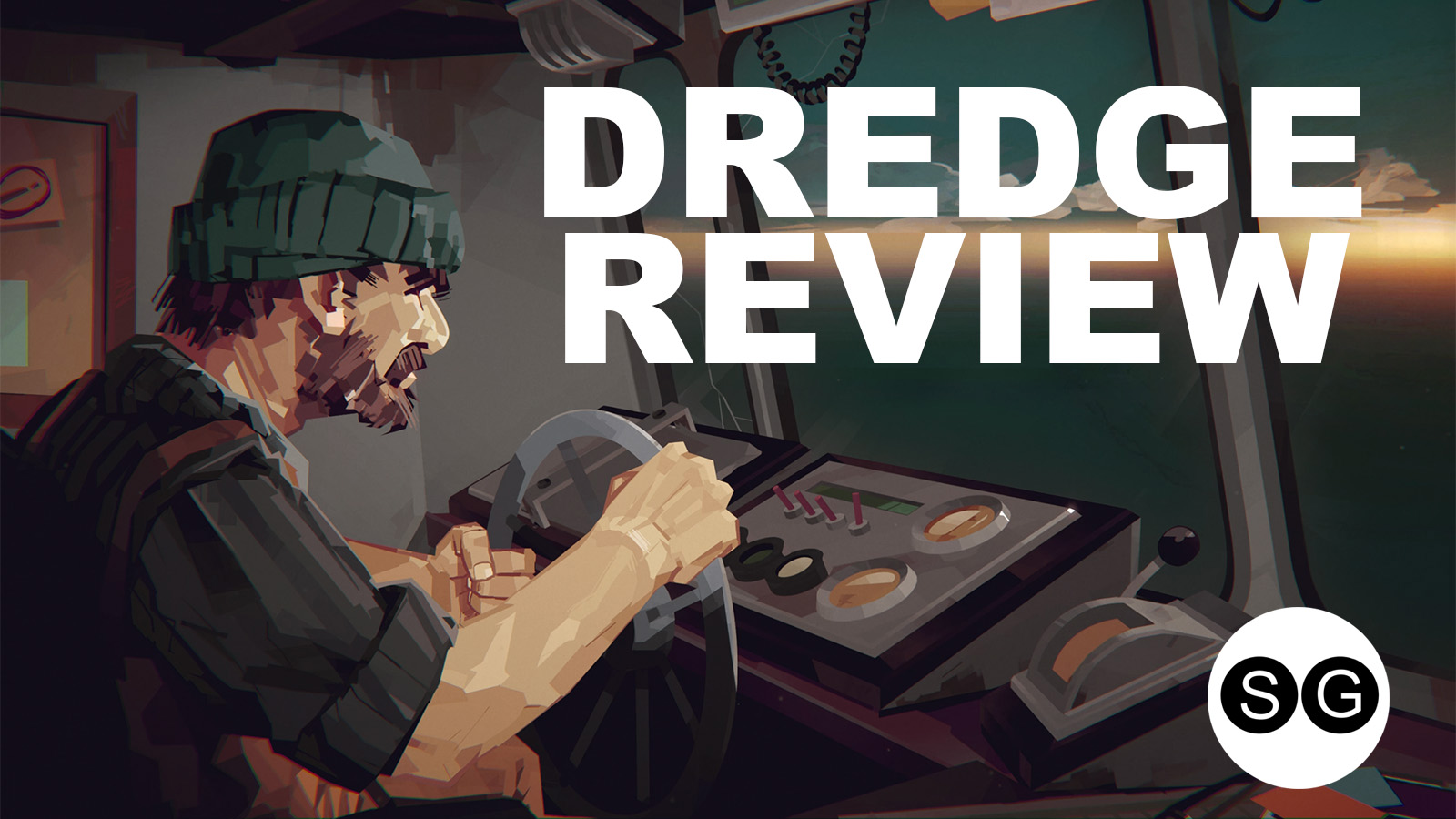Dredge review: Secrets, madness, and lots of fish
I was first introduced to Dredge last year after watching a demo gameplay video by YouTuber Gab Smolders, and I instantly wanted to get my hands on the indie horror game. Now, after acquiring the Platinum trophy (Something I don’t do very much) and rinsing it for gameplay completely, I can say that Dredge is the Lovecraftian fishing game I never knew I needed.
For anyone that doesn’t know, Dredge – developed by the four-person team of Black Salt Games and published by Team17 – is a single-player fishing game that follows an unnamed fisherman who takes on the role of Angler in the seaside town of Greater Marrow. What starts as a simple story of you helping to keep the town of Greater Marrow and its across-the-shore sister village Little Marrow fed transforms into a 10 to 15-hour madness-inducing adventure with Cthulhu-like monsters, lots of existential dread, twists, and secrets.


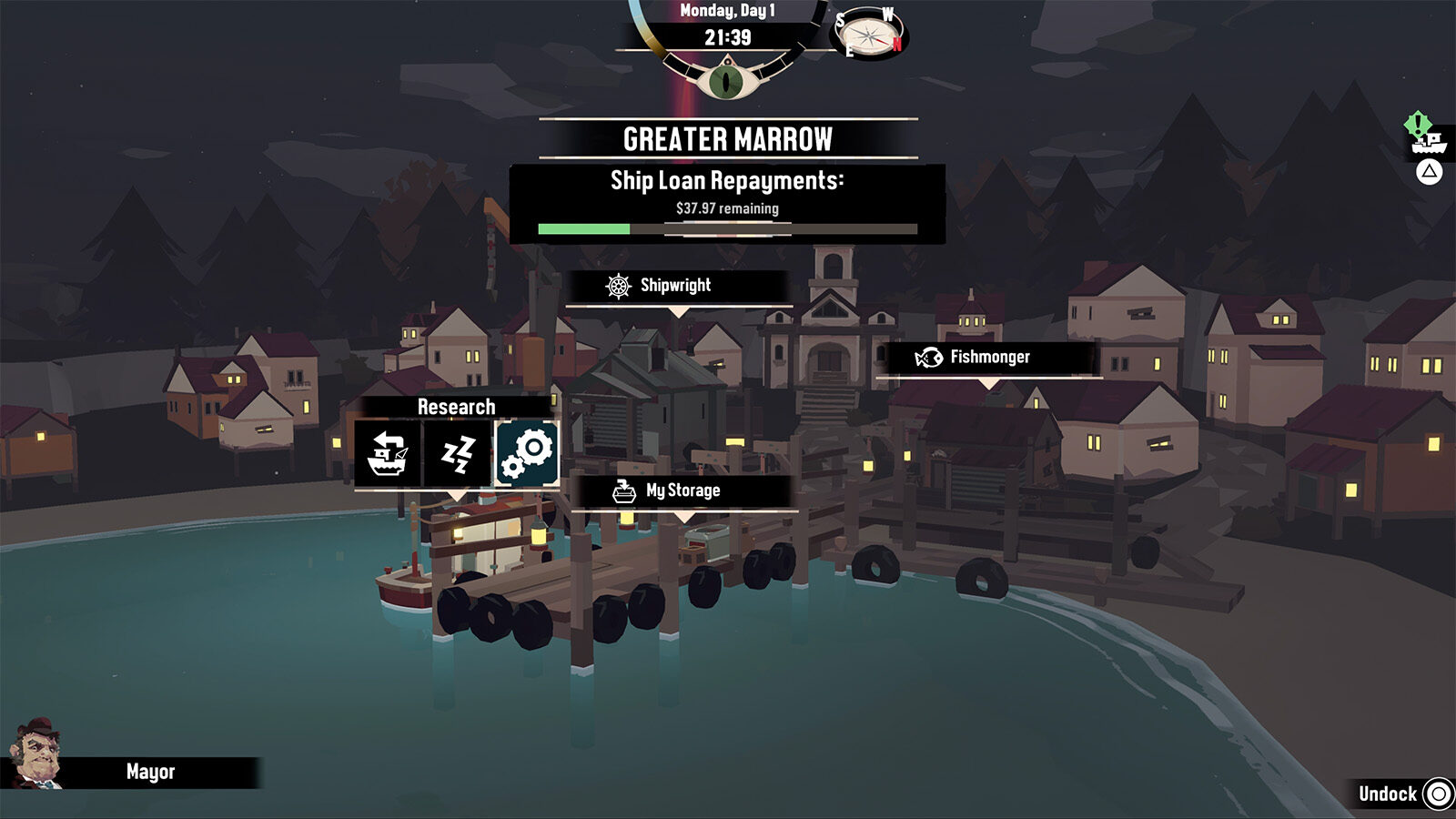
Dredge combines the simplicity of a fishing simulator with the cosmic horror inspired by the works of author H.P Lovecraft. The result is a fun and moreish indie title that kept me playing into the late hours of the night while telling myself that I only wanted to catch that fish or explore that island – white lies that inevitably led to another hour or two of gameplay that only stopped when my cat yelled for bedtime at 1 AM on a Tuesday night.
Sailing The Seas
The game starts slowly, with you working to pay off your loan for a new trawler after shipwrecking near Greater Marrow, meeting the residents of Greater and Little Marrow, and completing a few simple missions – known as Pursuits in the game. Soon after, things begin getting fishy as the residents of Greater Marrow desperately urge you to return to town before nightfall, you discover that the previous fisherman for Greater Marrow mysteriously disappeared, and, after braving the seas at night, are subjected to red glowing lights in the distance, unintelligible whispering, and monster fish attacks.
The strangeness culminates when you meet a mysterious local known as The Collector that lives in a secluded mansion on an island between The Marrows and fuels the game’s main story by sending you on a quest to uncover relics across the game’s five major regions; your starting location of The Marrows, the tropical Stellar Basin, the claustrophobic swamps of Twisted Strand, the former whaling town of Gale Cliffs, and the spooky ruins of Devil’s Spine.
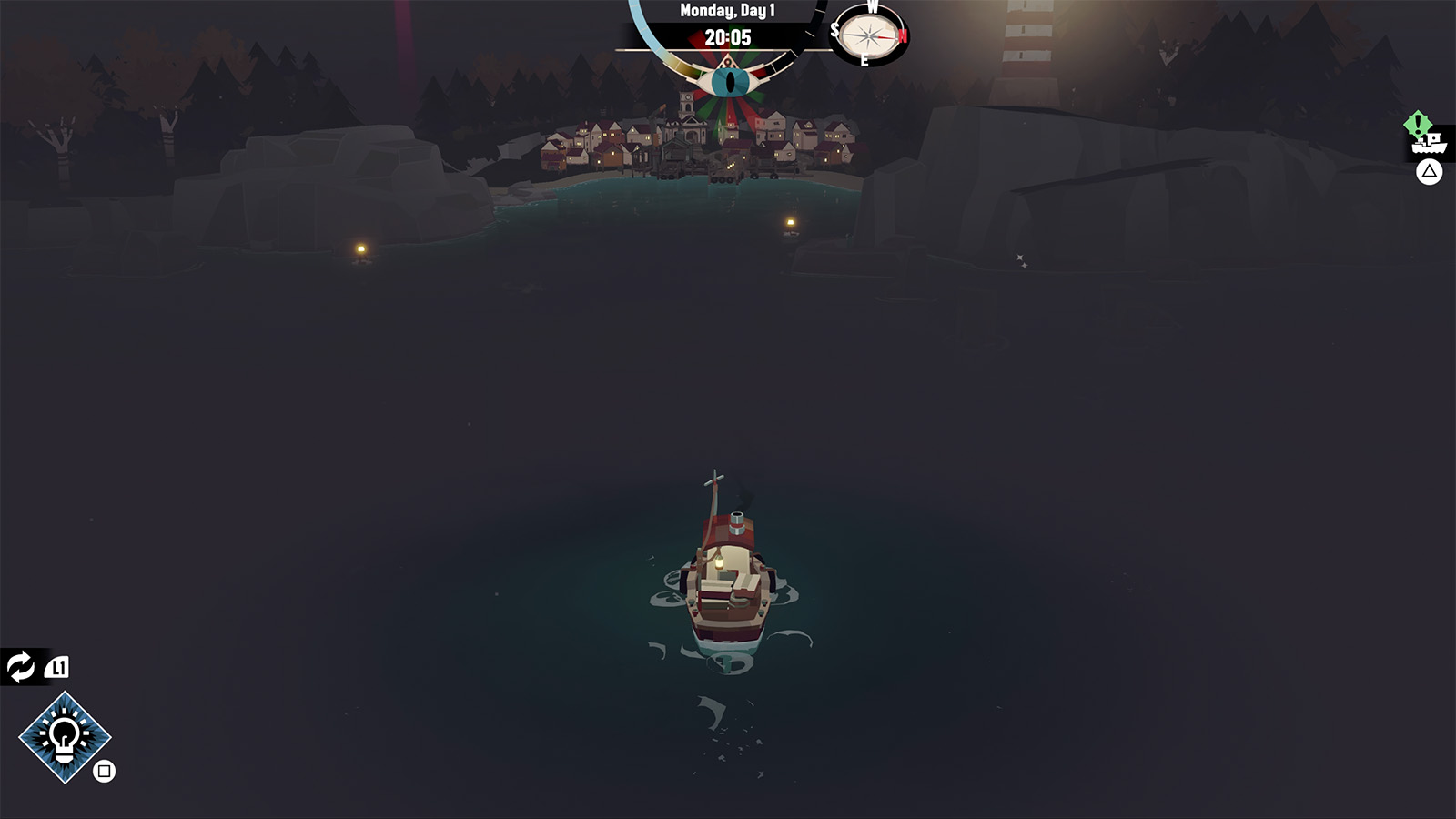
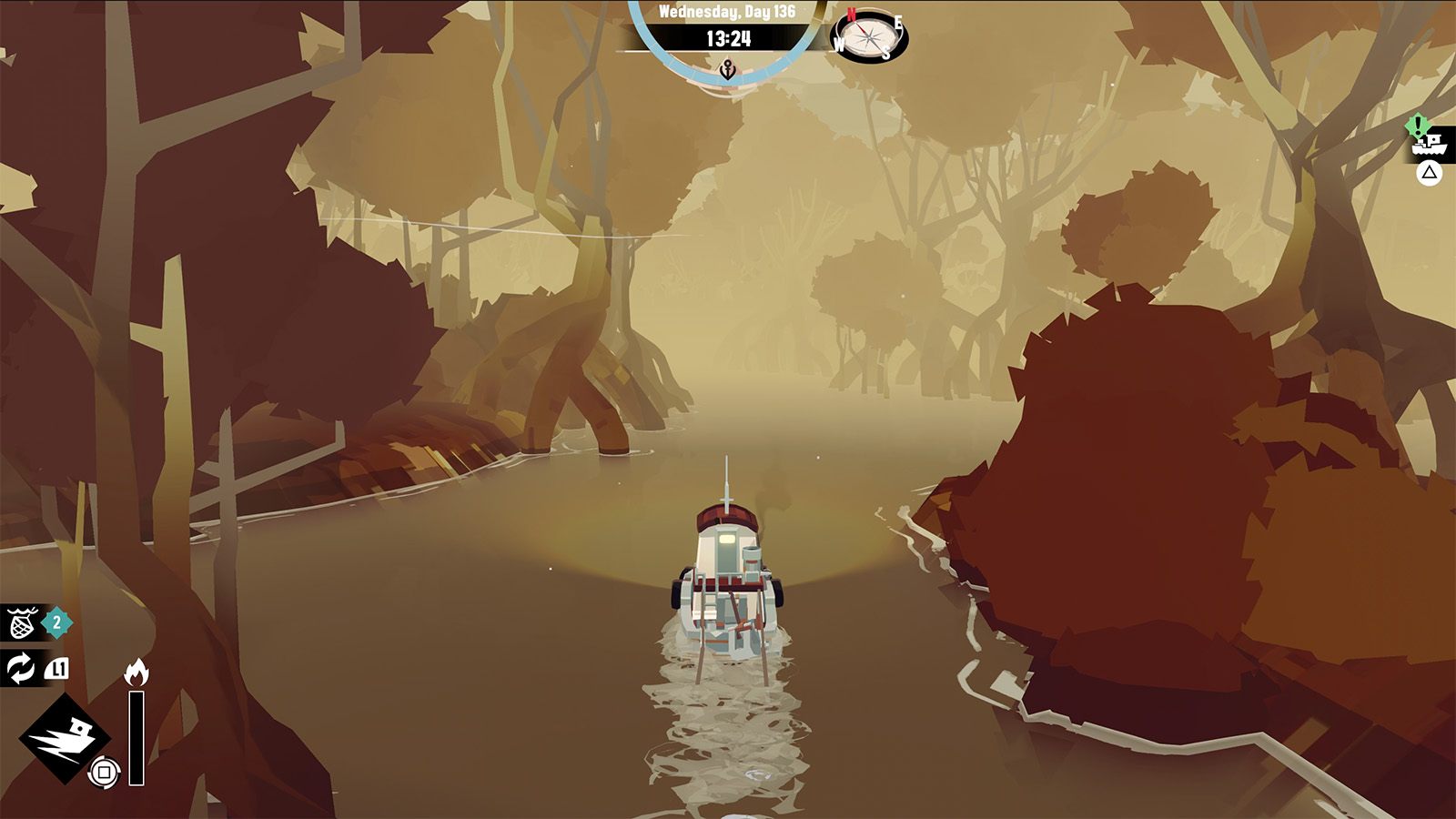


The diverse regions is one of the areas where Dredge shines, as each is uniquely different from the last. Gale Cliffs requires you to navigate rocky, rumbling cliffsides, Twisted Strand requires you to sail through a narrow, wooded swamp, and Devil’s Spine sees you move through submerged ruins, all while trying to avoid hitting anything that will risk you losing or damaging equipment, cargo, and the ship.
Each location in Dredge is home to its own selection of fish to catch, as well as NPCs related to the major Pursuit of each island, a majority of which subsequently tie into the game’s main story of relics or are their own branching side quests.
There are also threats – patrolling monster fish or water-emerging creatures that only attack when you move – that you must work out how to avoid or overcome at each location. The combination of tricky-to-navigate environments with each threat leaves you in a constant state of alertness which is made all the worse at nighttime, and you’ll have to go out at night.


The regions all come with varying environmental and audio effects that amplify the game’s atmosphere, and Dredge does a fantastic job at making sure each region feels and sounds different, from the rumbling of mountainous cliffs or the screeches of tropical birds. These simple effects cement each location as its own entity. Dredge’s atmosphere is actually one of the highlights of the game for me, as Black Salt Games has managed to craft a game that had me swapping between several emotions on a whim, from a state of peacefulness to wariness to abject horror through vibrations on the controller signalling a threat, dark hums when interacting with ancient shrines, the whispering of demonic sea monsters, and the blare of a distant foghorn somewhere in the night despite you being the only fisherman.
But there aren’t just four major regions to explore in Dredge, as there are dozens of smaller islands dotted around the game’s map that are filled with secrets for you to uncover, whether that’s mysterious cult-like robed individuals requesting certain species of fish, shipwrecks to plunder for resources, fish shrine puzzles to complete, and encounters with NPCs. Thankfully, Dredge’s controls lend themselves to free-form exploration; the ship is smooth to control, reacting to each movement you make but with enough weight that holding the controller for a second too long can lead you to smack into a rock and damage the ship. However, much of the game’s controls are influenced by the engines you use, and the ship will feel sluggish and slow at the start of the game but speeds up once you research and unlock better engines. By the end of the game, I could move between regions within a few short minutes or in-game hours, rather than making a day’s worth of a journey.
Fishy Happenings
The world of Dredge isn’t huge, but it’s just the right size to include plenty of variety in its locations and secrets. While exploring, you’ll spend a lot of time fishing – the game is a fishing sim, after all – and Black Salt Games nailed it. The core gameplay loop requires you to sail across the game’s waters, stop at pools of fish, and then use your rod to complete a timed, puzzle-based mini-game before stacking everything you’ve caught Tetris-style into your cargo alongside your equipment – lights, engines, rods, nets, etc. This game of space management becomes harder as you seek out larger fish, occasionally damage your cargo and reduce its space, and use larger or more equipment to get by.
Fish come in different categories, and you’ll need to use different types of equipment to catch them. Some rods will allow you to only catch shallow and coastal fish, while others only allow oceanic or abyssal or a combination of other types. This forces you to plan ahead depending on the region you’re exploring, switching out, upgrading, and purchasing equipment at every chance you get. But some fish can’t even be caught using rods either! Some will need to be caught in trawlers and critters in dispatched pots that must be checked each day and repaired after several. And I haven’t mentioned that certain fish can only be caught during the day or night. There’s a lot of planning and management involved. Thankfully, all caught fish are recorded in an encyclopaedia, which you can consult at any time should you need to catch a previously-caught fish for a Pursuit.
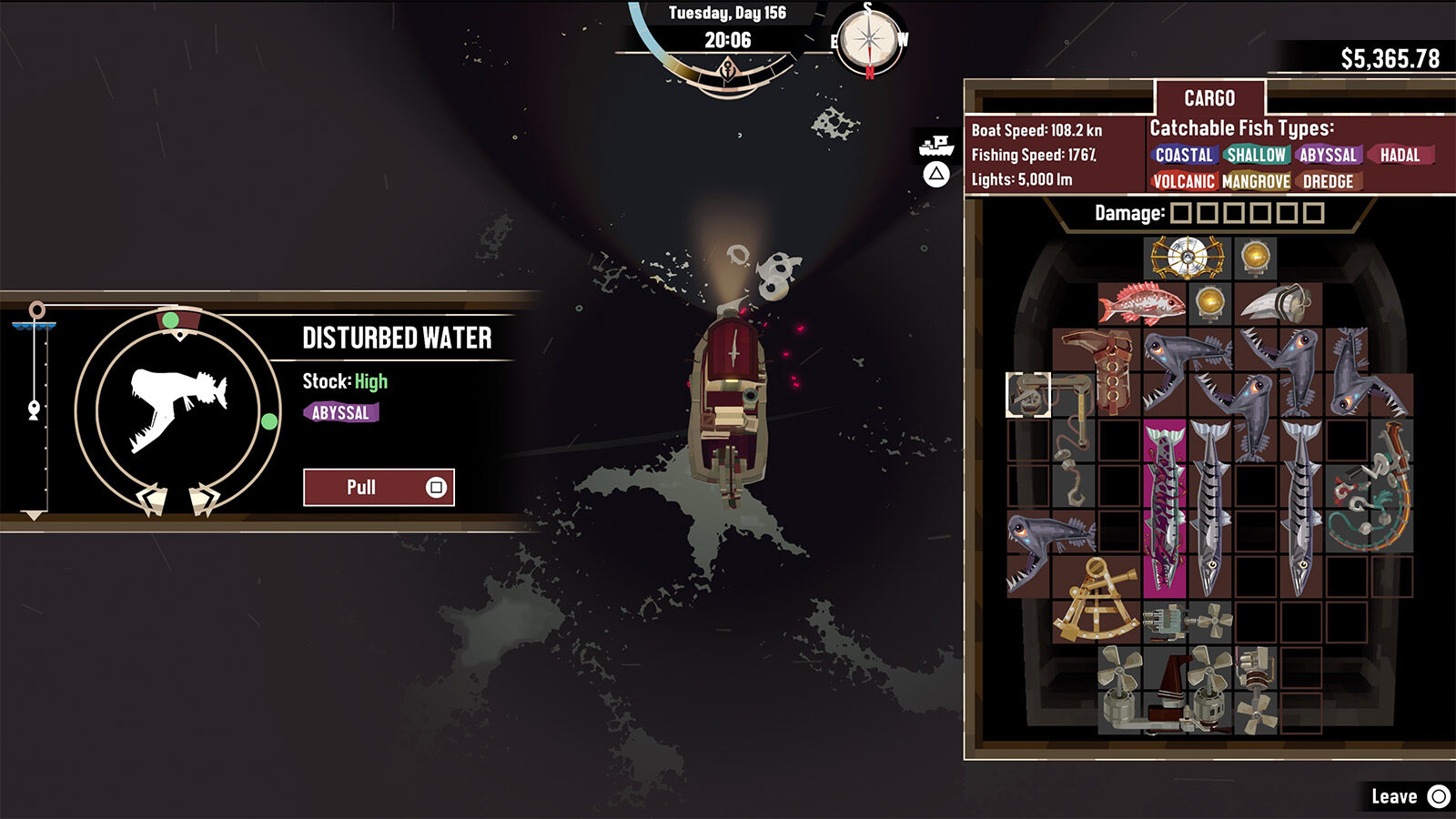

To tie into the game’s Lovecraftian roots, there are several dozen fish aberrations (Mutated fish) that you can collect. These aberrations are sold for a higher price to the travelling merchant and the fishmonger of Greater Marrow – my first time selling an aberration saw the fishmonger slam the door of his shop in my face and disappear for several days, leaving me wondering what he did with the mutant catch-of-the-day – and they all add to the game’s whopping total of 128 collectable fish.
It’s not just fish that you need to catch, though. While exploring shipwrecks, you can dredge resources – cloth, wood, scrap, and metal – that you’ll use to upgrade your cargo. The game’s upgrade tree is split into four tiers, and you’ll need to upgrade the cargo spaces for your rods, engines, and lights before expanding your cargo, a process that requires you to find the resources and apply them to the respective upgrade project before purchasing them from the shipwright or travelling merchant, who both also conveniently repair and sell goods. Unlike with fish, the timed mini-games for resource dredging plays on a rotating doughnut of two lanes that you’ll need to alternate between to avoid hitting obstacles and slowing the dredging process down.
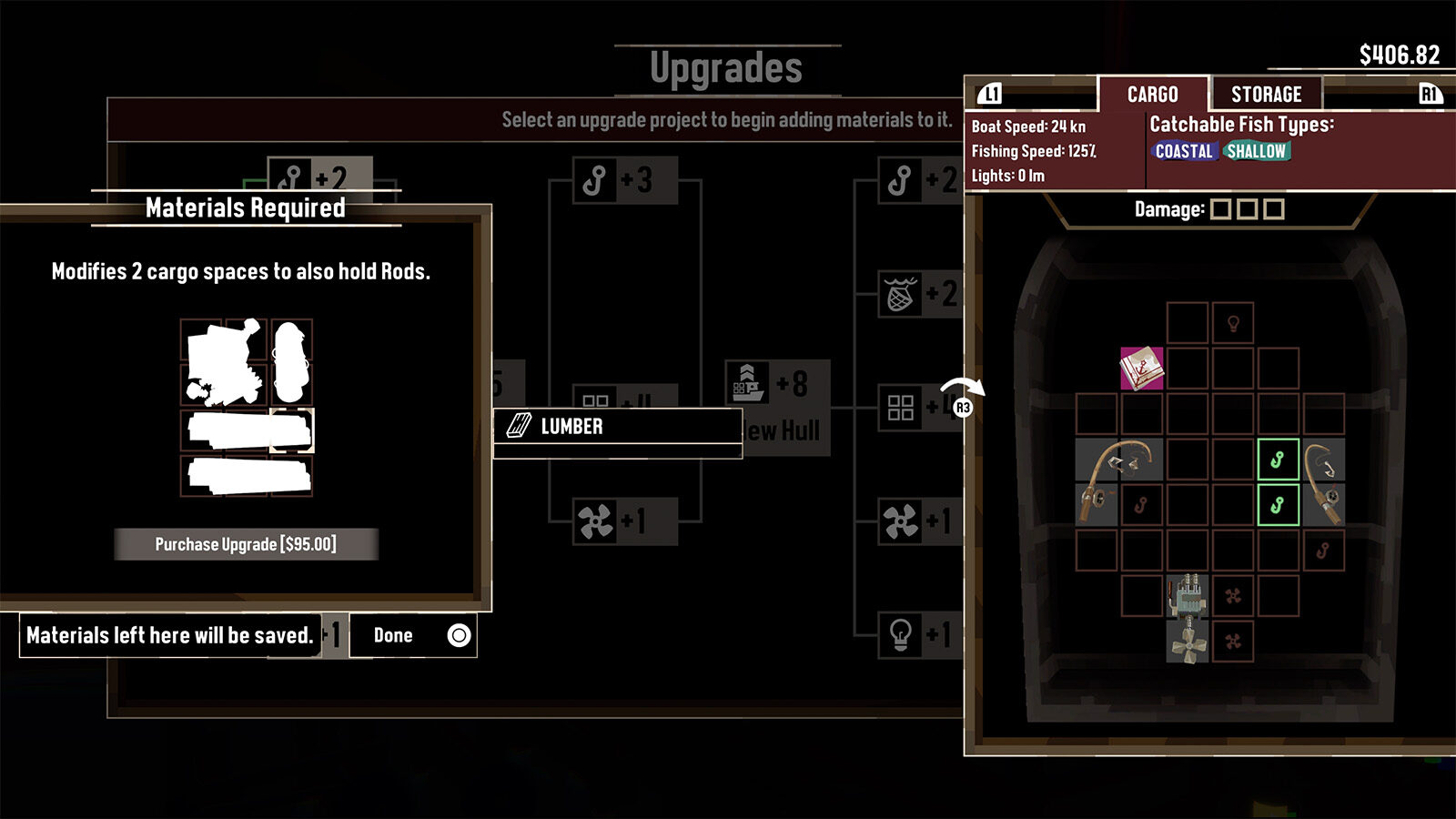
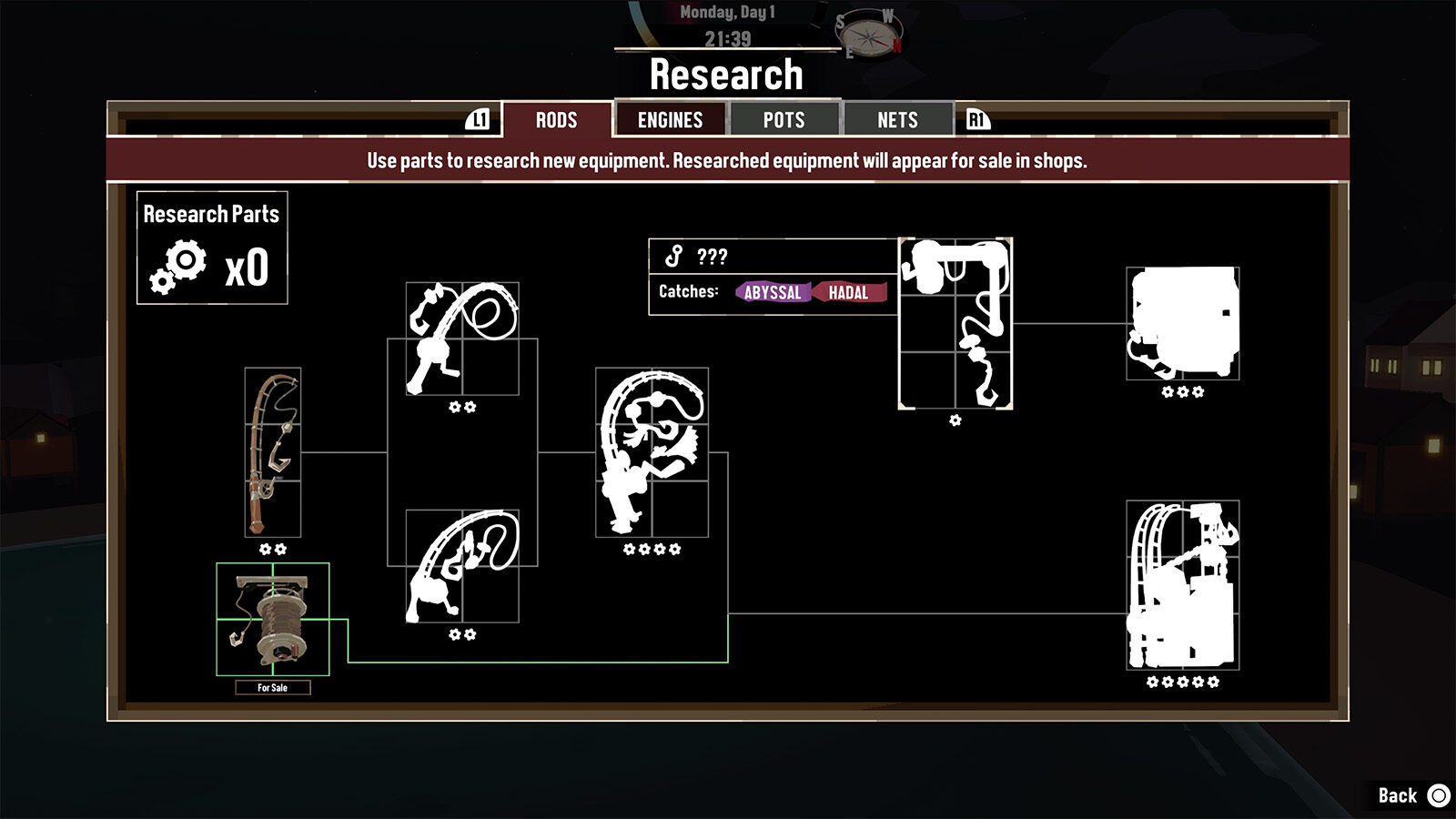
Upgrades extend to your equipment too, which you need to research to unlock before they can be purchased from the shipwright. Much like the upgrade tree, Dredge has individual research trees for rods, engines, pots, and nets, and you’ll need to acquire and apply multiple research parts – found while dredging resources, bought from the travelling merchant, or given as a reward for completing Pursuits – to each locked item before moving to the next or purchasing them. Unfortunately, this was one of the only issues I had with the game, as I felt that progress was severely limited as research parts were at times hard to come by and I couldn’t improve my gear as fast as I would have liked.
The ever-changing fishing and dredging mini-games never became boring for me as they were consistently changing depending on the type of fish I was trying to catch. And Dredge does a great job of providing you with a range of different fish even if you’ve locked yourself to one region for an entire play session. But if you ever are in a rush for whatever reason, you do unlock an ability – there are several in the game you can use, like teleportation back to the safety of the Marrows – late in the game that allows you to instantly catch all fish within a spot using some form of cosmic magic, although it is on a cooldown timer so is impossible to exploit!
A Ticking Clock
While fishing throughout the day is a cosy and relaxing experience, things take a dramatic turn for the worst at night, where one of the game’s primary mechanics comes into play; madness – a staple in any Lovecraftian media. Exploring the world of Dredge at night is dangerous as visibility is reduced for greater environmental risk. More worrying is the coloured wisps of fog that can enshroud your ship and subject you to nonsensical whispers which build madness (Trackable via an eye located under the in-game clock that begins to dart around as you panic more) and can lead to attacks from the sea, air, and earth depending on your location in the game’s world. Thankfully, madness can be depleted by resting at any of the docks scattered around the game’s map.
The day-night cycle in Dredge and the threat of nightfall keep you on your toes throughout the game, even when you’ve become accustomed to the threats darkness brings. Your day starts at dawn 6 AM every day and moving and fishing keep the in-game clock ticking with night approaching around 7 PM. While you think the 13-hour window seemingly gives you plenty of time to fish and explore, it doesn’t. Time moves quickly in Dredge, and before you know it, you’ll see the sun set and the fog roll in, while the beam of Greater Marrow’s lighthouse shines in the distance as your only source of comfort.

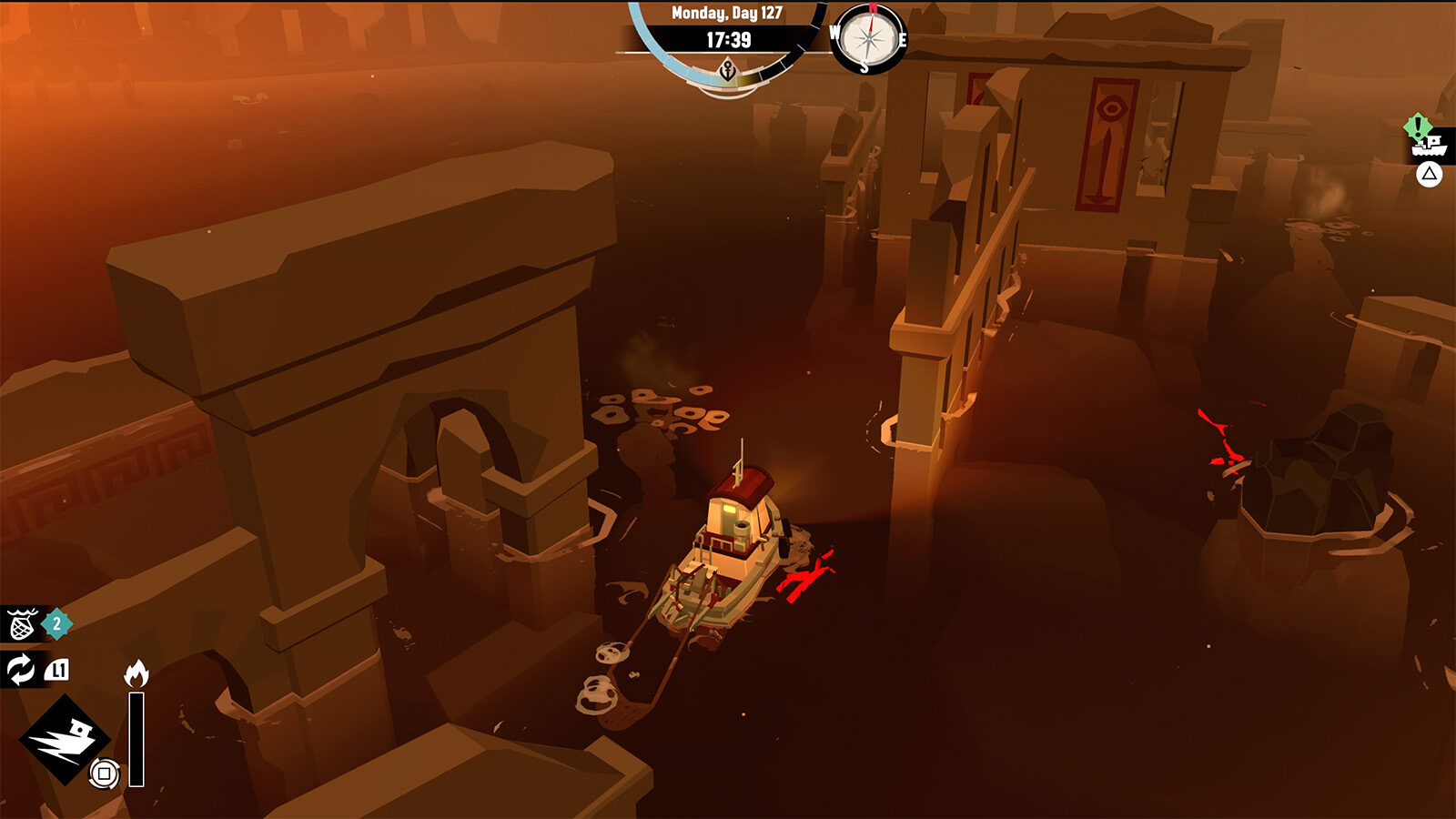
I often found myself preparing for a journey to a new location the night before departing at dawn, reaching the region at dusk, and then consulting my map in a desperate attempt to rush towards the nearest dock before falling victim to an attack from Lovecraftian monsters and the horror-inducing build-up of madness. There was a thrill, however, in getting lost at sea at night, with only my flickering light guiding my way to new abominations of fish, and by late game I found myself venturing out into the darkness to uncover the secrets I tried so hard to avoid at the start of the game.
Stark Storytelling
Amidst all of the gameplay in Dredge, there’s a story to be told. It’s simplistic in nature and it never takes precedence over exploration and fish catching, but it comes together in a somewhat ambiguous ending, which, if you weren’t exploring enough to uncover the clues left for you in a Dark Souls/Elden Ring-like fashion, will likely come as a surprise. It did for me, until I came upon a major realisation after unlocking one of the game’s two endings and collecting all of the game’s messages at sea.
Dredge’s ambiguousness was one of the things I loved most about my time with the game. Yes, a lot of NPC stories and quests were direct and clear-cut, but the majority of the game wasn’t. Characters never question the strange occurrences happening around them, they instead take these strange happenings as just part of their everyday life. Likewise, some questions raised throughout the game’s story are never answered directly but alluded to, leaving you to string together the few clues left for you and form an independent interpretation of the story.
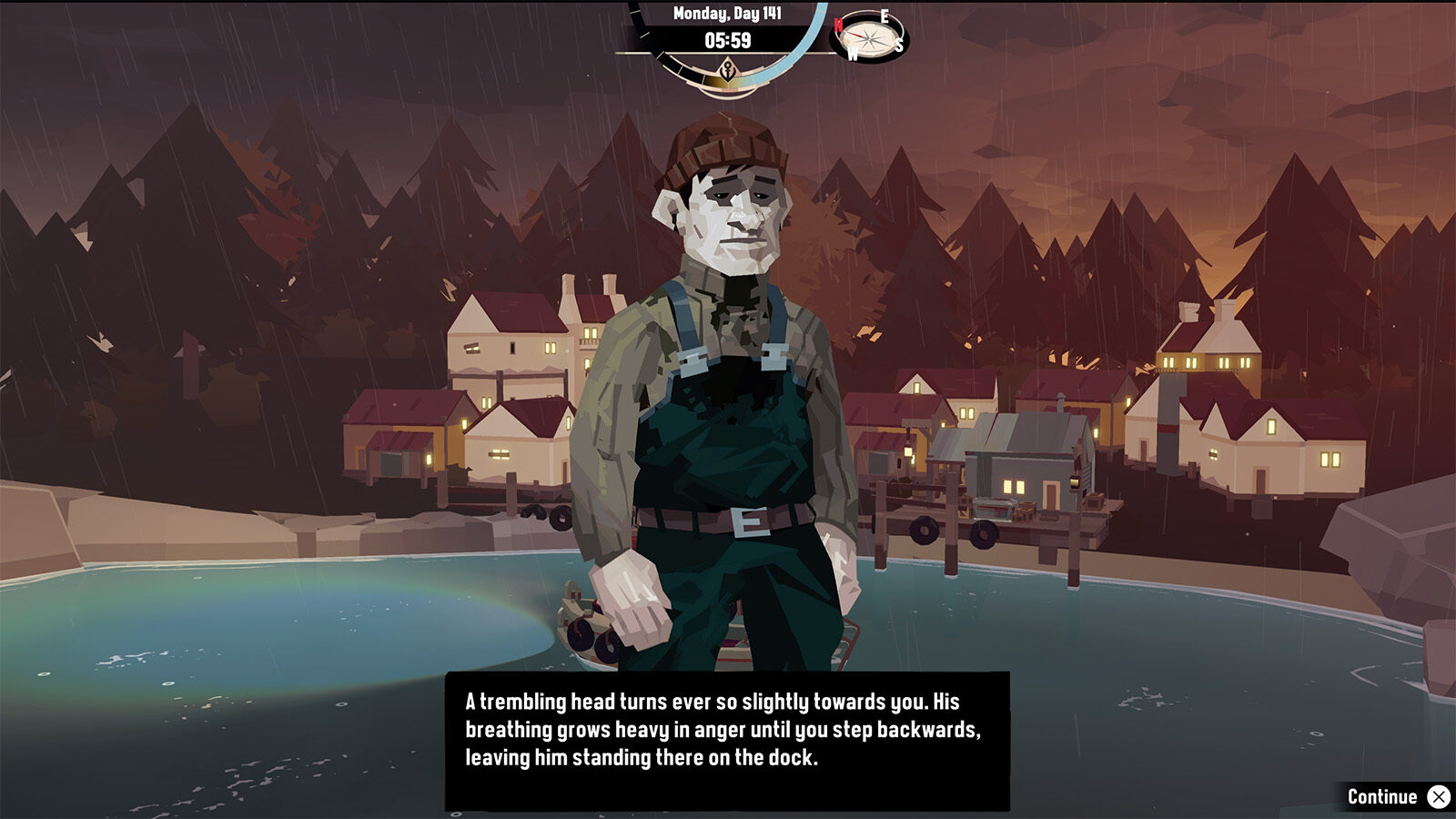
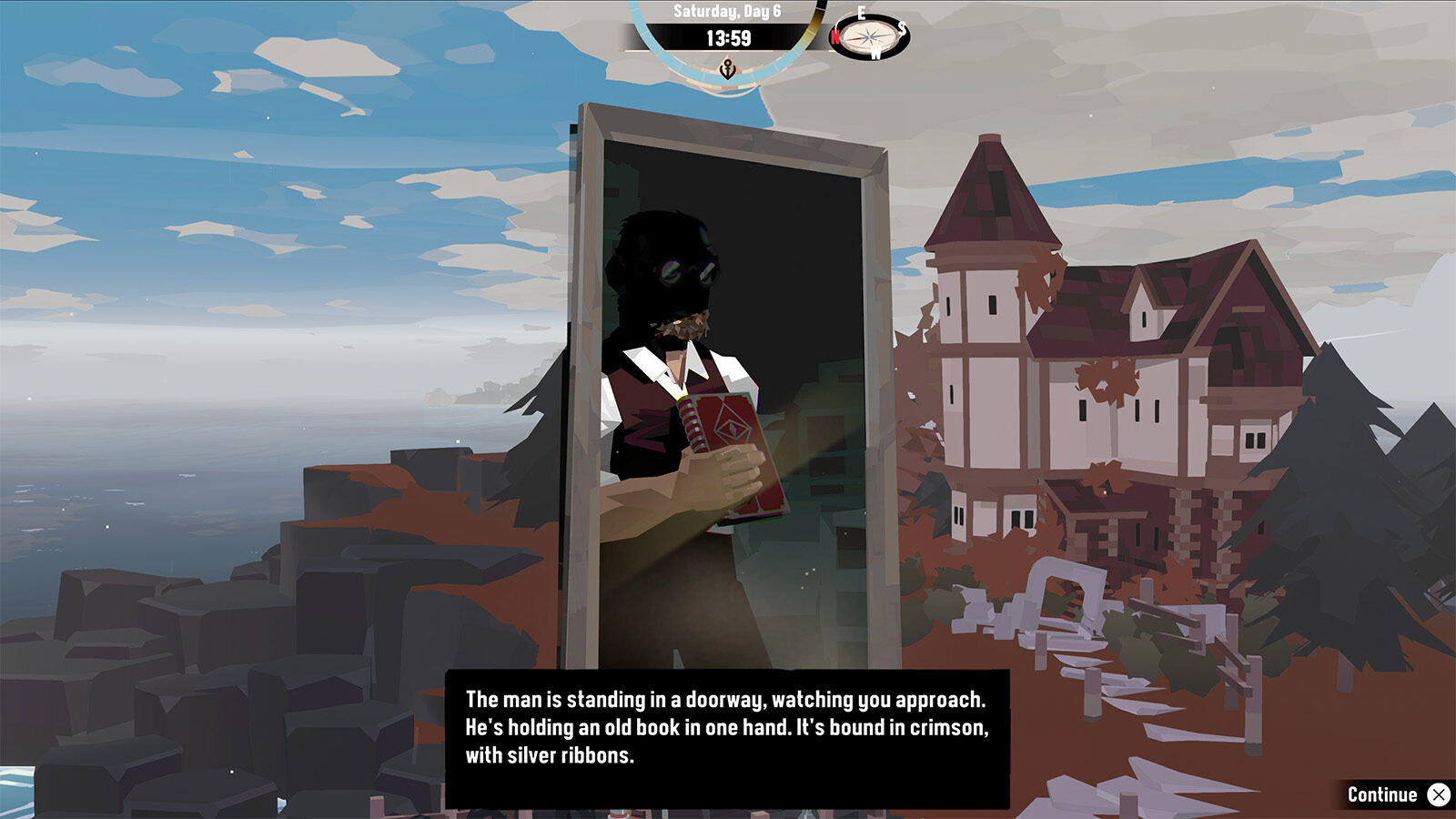
Would I have loved to know more about the world and monsters of Dredge? Absolutely, but I think the lack of concrete information adds charm and mysticism to the game. That might not work for you, but it absolutely did for me.
Final Opinion
Dredge is without a doubt one of the best indie games I’ve experienced in recent years. The game manages to combine elements of cosy fishing and horror survival gameplay that, on paper, shouldn’t mesh but somehow work together perfectly and even complement each other. Many might dislike the way Dredge refuses to hold your hand after the tutorial and leaves much to self-exploration, but that was one of the many highlights for me. The game’s art style is gorgeous to look at, the music phenomenal, and the gameplay fun, stressful, relaxing, and terror-inducing all in one package. The game is a no-brainer for anyone that enjoys any Lovecraftian media, and, much like the fish you catch, Dredge is an anomaly of an indie fishing game, but a delightful and unforgettable one at that.
Dredge (2023) - Final Thoughts
Black Salt Games’ debut title Dredge is an amalgamation of fishing sim and Lovecraftian horror, which creates a compelling and moreish video game that you’ll want to keep playing into the early hours of the morning if you can survive the terrors of the night, that is.
Review copy provided by Team17 for PlayStation 5.
Dredge launches on March 30th for PC via Steam, Nintendo Switch, and all PlayStation and Xbox consoles.

